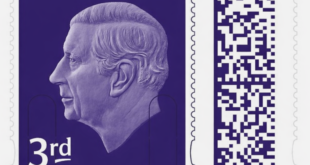Are you a stamp collector or a space enthusiast? If you’re both, thank your lucky stars. The Royal Mail has just revealed images of eight new special stamps that will be issued to commemorate the Royal Astronomical Society’s (RAS) 200th anniversary.
The stamp collection, called ‘Visions of the Universe’, features eight illustrations depicting astronomical phenomena that were either discovered or have been extensively studied and researched by astronomers and astrophysicists from the RAS.
RELATED: THE ROYAL SOCIETY ANNOUNCES BEST SCIENCE PHOTOS OF THE YEAR
Illustrated by artist Robert Ball, the collection provides a window into our universe, as well as Britain’s rich history of observing the cosmos.
The fascinating collection is due to be released on general sale from February 11, 2020. Have a look at the stamps below.
1. Cat’s Eye Nebula
The Cat’s Eye Nebula is an expanding gas cloud that was once a star, much like our Solar System’s own Sun. It was discovered by William Herschel, the RAS’s first president.
In 1864, William Huggins analyzed the nebula using the technique of optical spectroscopy, in which light from a source in space is split into an artificial rainbow and analyzed, to understand its elemental composition.
Huggins discovered that the Cat’s Eye Nebula was a gas cloud rather than a solid object, and was awarded the prestigious Gold Medal of the Royal Astronomical Society for his efforts.
2. Geysers on Enceladus
Enceladus is a small icy moon belonging to Saturn. The stunning stamp by illustrator Ball depicts a phenomenon connected to an ocean on the moon that researchers recently discovered contains the molecular building blocks for life.

Enceladus contains a system of geysers that spray water into space. They were discovered by NASA’s Cassini spacecraft, thanks to a British-built magnetometer instrument onboard.
When astronomers observed that Enceladus possessed a thin atmosphere, Michele Dougherty, of Imperial College London, convinced the NASA team to send Cassini for a closer look at the moon’s surface. That’s how the Enceladus geysers were discovered.
3. Pulsars
As this stamp says, pulsars are rapidly rotating neutron stars. They are so dense that they fit the mass of the Sun into an area just 15-20km in diameter.
Pulsars, formed by the collapse of a massive star, were discovered in 1967 by British astronomers Jocelyn Bell (later Bell Burnell) and Antony Hewish, who later became RAS president.

Using a pioneering radio telescope designed by Hewish, Bell discovered a celestial radio pulse emanating from the sky every 1.3 seconds. The two initially had no idea what the object was and jokingly named it LGM-1, standing for Little Green Men.
4. Black Holes
Nothing can escape the gravitational pull of a black hole. The density of matter in their vicinity is so great that they create an area that could be characterized as a plug hole in space, sucking up surrounding planets and stars.

The existence of black holes was first suggested by English natural philosopher John Michell, in 1783. In 1916, their behavior was mathematically described by German physicist Karl Schwarzschild.
Only in the 1960s, however, was their existence widely accepted by the scientific community. Of course, just last year we saw the first-ever image of a black hole thanks to the Event Horizon telescope.
Stephen Hawking was awarded the Royal Astronomical Society’s Gold Medal in 1985, largely for his key predictions about black hole behavior.
5. Jupiter’s Auroras
Much in the same was as Earth, Jupiter experiences auroras in its poles. These are produced when charged particles accelerate into the atmosphere, illuminating the sky as they collide with gas atoms.
On Earth, we can see these auroras with the naked eye. However, on Jupiter, they are only visible in the ultraviolet part of the spectrum and as X-rays.

On Earth, the auroras are powered by the strong voltages in our magnetic field. In Jupiter, this doesn’t seem to be the case, and researchers have yet to discover what causes the phenomenon on Jupiter. A team of astronomers at the University of Leicester is currently investigating the cause.
6. Gravitational lensing
This fascinating phenomenon was predicted by Albert Einstein’s General Theory of Relativity. It occurs when enormous celestial objects bend light from distant light sources.
The large celestial bodies magnify light from distant galaxies. Essentially, gravity acts as a magnifying glass, allowing us to observe gravitational lenses and see further into the universe.

Though predicted by Einstein, the concept was confirmed in 1979 when an Anglo-American team of astronomers discovered two distorted galaxies side by side. They realized that both galaxies appeared to be identical. What they were really seeing was the same image distorted by a gravitational lens.
NASA will soon train its James Webb Telescope on a gravitational lens to see into the far reaches of our universe’s past and investigate the birthplace of stars.
7. Comet 67P
Comet 67P is an icy space object that was explored by the European Space Agency’s Rosetta mission. UK’s universities and industries contributed to and worked on the mission’s lander and instruments.

The comet is just 4.3km long. Thanks to ESA’s mission we now know that 67P is an ancient rock that formed before planets in our universe. It is more than 4.5 billion years old.
8. Cygnus Galaxy
Cygnus A is a radio galaxy. It is one of the strongest sources of radio signals in the observable universe.
In the early 1950s, the Jodrell Bank radio observatory in Cheshire, UK, discovered that the radio signals were not coming directly from the galaxy. They were emanating from a pair of radio lobes, one on either side of the visible galaxy.

It is believed that strong magnetic fields are causing jets of particles to accelerate away from the center of Cygnus A. These, in turn, collide with rare atoms in the space surrounding the galaxy, causing the radio lobes to let out energy.
The origins of the Royal Astronomical Society date back to January 1820 when a group of 14 astronomers joined each other for dinner at the Freemasons’ Tavern, Lincoln’s Inn Fields, London. It is now one of the world’s leading learned societies and astronomical charities.
Will you be picking up this stellar set of space stamps? Can you think of any other strong contributions from the Royal Astronomical Society in the fields of astronomy and astrophysics that should have been commemorated by a stamp? Be sure to let us know.
Source link



